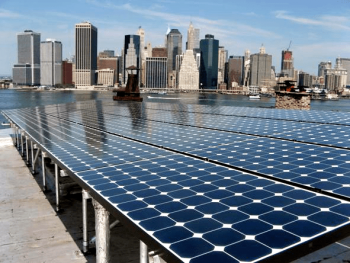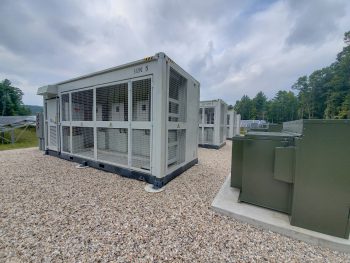Senate Standing Committee On Environmental Conservation - Written Testimony On The Climate And Community Protection Act
This testimony is submitted on behalf of David Gahl, the Senior Director of State Affairs for the Solar Energy Industries Association (SEIA). SEIA is the national trade association of the U.S. solar energy industry, which now employs more than 260,000 Americans. Through advocacy and education, SEIA is building a strong solar industry to power America. SEIA works with its 1,000-member companies to build jobs and diversity, champion the use of cost-competitive solar in America, remove market barriers and educate the public on the benefits of solar energy.
SEIZE THE MOMENT
SEIA urges the Executive and Legislative branches to work together this year to pass meaningful and reasonable energy legislation that encourages the growth of the solar industry. Final legislation should include near-term milestones for solar that allow the state to reach its long-term clean energy goals.
In 2018, the solar industry employed nearly 10,000 workers in New York, making it the fourth largest state in the nation for solar jobs. Sustaining this growth and market momentum can be achieved by enacting legislation that codifies the state’s short-term solar goals, requires all renewable resources to provide a significant portion of the state’s electricity needs, and ensures that solar energy is fairly valued by regulators.
BACKGROUND
SEIA, along with the support of partners from the renewable energy industry, leading environmental organizations, academic institutions, social justice organizations, and advocates for solar energy, have collaborated on the Million Solar Strong Campaign (https://www.solarstrongny.org/), an effort to set a bold new goal of powering a million households with solar by the year 2023. More than 40 New York State legislators have already endorsed this proposal (https://www.solarstrongny.org/voices/).
Our campaign is grateful to see that Governor Andrew Cuomo recently committed to creating a carbon-free electric system by 2040, increasing the state’s reliance on renewable energy for its electricity needs, and expanding the NY-Sun program to support 6 gigawatts of distributed solar 2 by 2025. This commitment would fulfill our campaign’s goal of powering one million households with solar as well as encouraging the further development of large-scale renewable resources.
The Cuomo Administration has proposed legislation in the SFY 2019-20 Executive Budget to codify a 2040 carbon-free electricity target, establish or continue a Public Service Commission (PSC) proceeding to obtain 70 percent of the state’s electricity from renewable resources by 2030, and create an administrative body to consider other regulatory measures to reduce the pollution causing climate change (S.1508/A.2008, Part X). This first-of-its-kind proposal from the Executive Branch is a welcome development and represents a major step toward enacting meaningful energy legislation this year.
Furthermore, for the past several years the New York State Assembly has passed landmark legislation that would reduce the emissions responsible for climate change, encourage the growth of renewable energy – including solar – and help set New York on the path to a more sustainable energy future. This legislation has been reintroduced in the Senate and the Assembly in 2019.
SOLAR INDUSTRY RECOMMENDATIONS
Ensuring that progress is made in the next five years will be critical to both realizing New York’s overall energy objectives and making sure families, businesses and communities see immediate and tangible benefits as the state transitions to a clean energy future.
Furthermore, New York’s transition to clean energy must transcend the status quo and ensure that every New Yorker has access to its benefits. This is particularly true for communities of color and low-income families who disproportionately bear the health, environmental, and economic burdens of our fossil fuel-based energy system and its climate impacts while seeing little of the economic benefits from that system. It is crucial that final legislation include serving at least 100,000 low-income households directly with cost-saving solar by 2025 to make this a more just transition and move towards equity in our energy economy.
Therefore, SEIA recommends that the Legislature work with the Governor’s Office to ensure that any final legislation includes the following:
1. Codification of Distributed Solar Goal
We strongly recommend the Legislature codify the standard of 6 gigawatts (GW) of distributed solar by 2025; enough to power 1 million households, including a goal of ensuring 20 percent of new residential-serving solar serves low-income (LI) customers, which we estimate will serve 100,000 families.
2. Additional Direction to State Agencies
We further urge the Legislature to direct the PSC to account for solar and climate pollution reduction targets in its regulatory decisions. While the PSC has a broad mandate, given the magnitude of the climate crisis, the Legislature should codify that promoting 3 renewable energy and meeting carbon reduction targets are part of its core mission and these goals should guide decisions on determining the full, accurate and avoided impacts of fossil fuels in its regulatory dockets.
Furthermore, we urge the Legislature to give similar additional direction to the State’s other regulatory authorities, such as the New York State Energy Research Authority (NYSERDA), the New York Power Authority (NYPA), the Long Island Power Authority (LIPA) and the Office of General Services to account for these goals in their regulatory and programmatic decisions.
SEIA supports the Governor’s proposal directing the PSC to commence or modify a proceeding to establish a clean energy program to meet 70 percent of statewide electrical demand with renewable energy sources. Furthermore, we strongly recommend that the Legislature advocate for final legislation to include provisions directing NYSERDA to hold and announce procurements for large scale renewable energy annually, through 2030. In addition, the Legislature should require and direct the PSC to set minimum annual percentage target requirements for load serving entities on a 10-year rolling basis to give increased visibility into the renewable energy needs of meeting the overall clean energy objective.
As part of this goal, the Legislature should require utilities to purchase 2 percent of load through long-term, bundled power purchase agreements, which has proven to be one of the most cost-effective ways to promote large scale renewable energy development across the country. This approach was found to produce significant ratepayer savings when compared to other options in a paper entitled, “Large Scale Renewable Energy Development in New York: Options and Assessment” published by NYSERDA in June 2015.
3. Equitable Clean Energy Funding/Mobilizing the NY Green Bank
Within two years, require at least 40 percent of uncommitted climate and clean energy funding from the Clean Energy Fund, Regional Greenhouse Gas Initiative and New York Green Bank go to programs serving low- and moderate-income (LMI) customers or communities. This is an equitable share of funding based on the state’s population.
We further recommend that the Legislature codify the New York Green Bank (NYGB) and clarifies its mission includes financing for equitable deployment of clean energy, such as subsidizing financing for low and moderate income (LMI) customers and community-owned or – controlled projects serving or in LMI communities.
4. Low-Income Stakeholder Engagement
We further recommend that the Legislature create a stakeholder advisory board to provide direction and recommendations to the PSC, NYSERDA and the NYGB on how to expand access to solar and other clean energy technologies and programs. This advisory board and these agencies would be tasked with the creation of a roadmap for expanding the direct benefits of solar going to low-income communities and achieving the 100,000 solar low-income households goal. This advisory board would consist of these agencies as well as 4 representatives of low-income and environmental justice communities, the clean energy industries and the environmental community.
5. Accountability
Lastly, we recommend the Legislature direct NYSERDA to issue an annual report to the Governor, the PSC and the Legislature detailing: 1) the state of the solar sector and other clean energy industries, including projected growth and a breakdown of different geographic, project and customer types, including low-income customers; and 2) the state of state clean energy funding, with a specific accounting of funds going directly to serve LMI families and communities.
Thank you for the opportunity to submit written testimony on S.2992. We look forward to working with you in the coming weeks to enact legislation and then implement the necessary policies to ensure the growth of the solar industry in New York.
For more information contact:
David Gahl, Senior Director, Solar Energy Industries Association (dgahl@seia.org) James Walsh, Partner, Manatt, Phelps & Phillips (jwalsh@manatt.com)



